Beech Model 73 Jet Mentor on:
[Wikipedia]
[Google]
[Amazon]
The Beechcraft T-34 Mentor is an American propeller-driven, single-engined, military trainer aircraft derived from the Beechcraft Model 35 Bonanza. The earlier versions of the T-34, dating from around the late 1940s to the 1950s, were piston-engined. These were eventually succeeded by the upgraded T-34C Turbo-Mentor, powered by a turboprop engine. The T-34 remains in service more than seven decades after it was first designed.
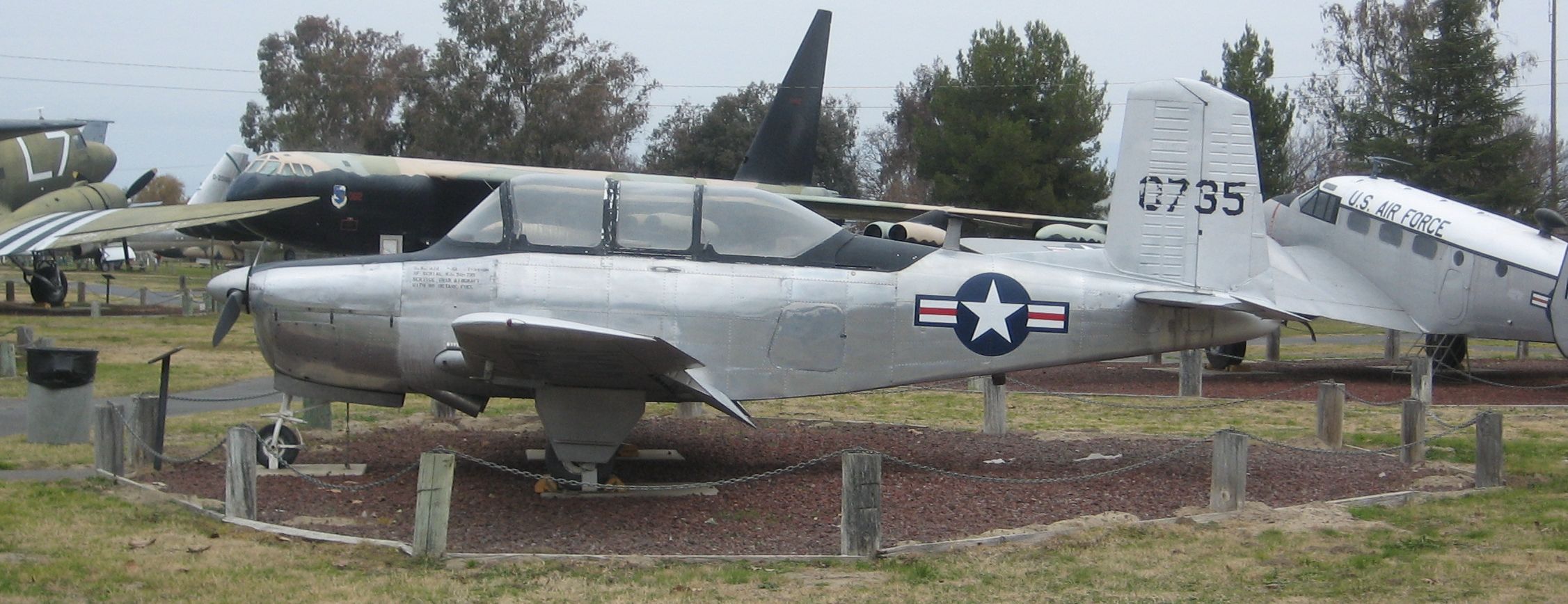
 Three initial design concepts were developed for the Model 45, including one with the Bonanza's signature V-tail, but the final design that emerged in 1948 incorporated conventional tail control surfaces for the benefit of the more conservative military (featuring a relatively large unswept vertical fin that would find its way onto the Travel Air twin-engine civil aircraft almost ten years later). The Bonanza's fuselage with four-passenger cabin was replaced with a narrower fuselage incorporating a two-seater tandem cockpit and bubble canopy, which provided greater visibility for the trainee pilot and flight instructor. Structurally, the Model 45 was much stronger than the Bonanza, being designed for +10 ''g'' and −4.5''g'', while the
Three initial design concepts were developed for the Model 45, including one with the Bonanza's signature V-tail, but the final design that emerged in 1948 incorporated conventional tail control surfaces for the benefit of the more conservative military (featuring a relatively large unswept vertical fin that would find its way onto the Travel Air twin-engine civil aircraft almost ten years later). The Bonanza's fuselage with four-passenger cabin was replaced with a narrower fuselage incorporating a two-seater tandem cockpit and bubble canopy, which provided greater visibility for the trainee pilot and flight instructor. Structurally, the Model 45 was much stronger than the Bonanza, being designed for +10 ''g'' and −4.5''g'', while the
"A Short History of the Beechcraft Mentor."
''philfarq.com''. Retrieved: 13 November 2007. T-34A production was completed in 1956, with T-34Bs being built until October 1957 and licensed B45 versions built in Canada (125 manufactured by Canadian Car and Foundry), Japan (173 built by Fuji Heavy Industries), and Argentina (75 by FMA) until 1958. Beechcraft delivered the last Model B45s in 1959. Total production of the Continental-engined versions in the US and abroad was 1,904 aircraft.
 In 1955 Beechcraft developed a jet-engined derivative, again as a private venture, and again in the hope of winning a contract from the US military. The Model 73 Jet Mentor shared many components with the piston-engined aircraft; major visual differences were the redesigned cockpit which was relocated further forward in the fuselage and the air intakes for the jet engine in the wing roots, supplying air to a single
In 1955 Beechcraft developed a jet-engined derivative, again as a private venture, and again in the hope of winning a contract from the US military. The Model 73 Jet Mentor shared many components with the piston-engined aircraft; major visual differences were the redesigned cockpit which was relocated further forward in the fuselage and the air intakes for the jet engine in the wing roots, supplying air to a single
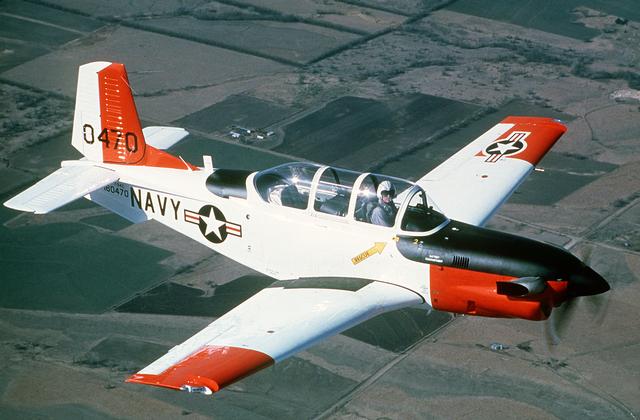 After a production hiatus of almost 15 years, the T-34C Turbo-Mentor powered by a
After a production hiatus of almost 15 years, the T-34C Turbo-Mentor powered by a
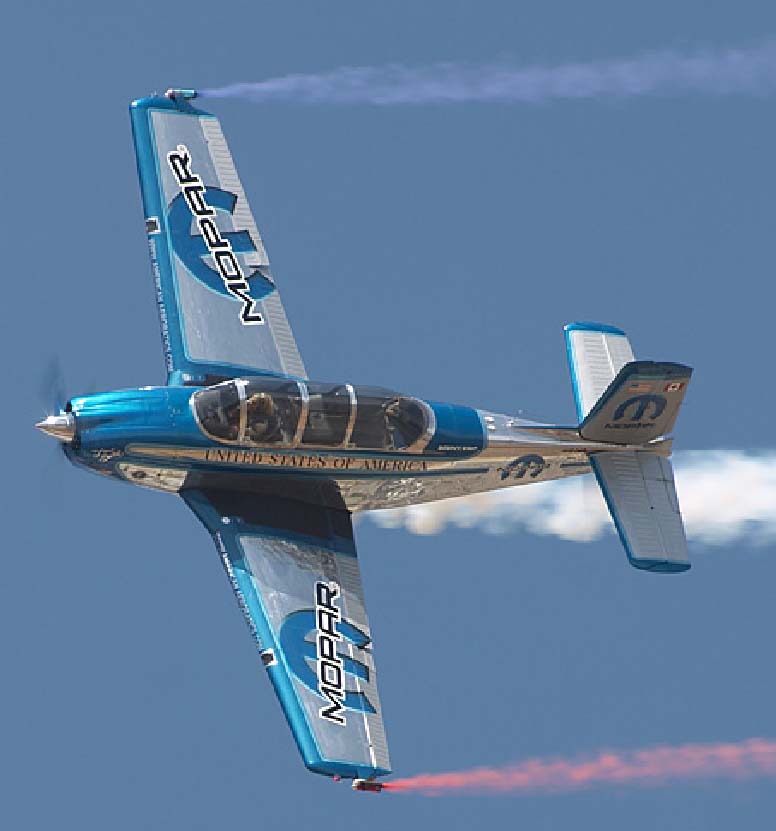 In 2004, due to a series of crashes involving in-flight structural failure during simulated combat flights, the entire US civilian fleet of T-34A/Bs was grounded by the Federal Aviation Administration. The grounding has since been eased to a slate of restrictions on the permitted flight envelope. Via a series of Airworthiness Directives (ADs) established by or Alternate Methods of Compliance (AMOCs) negotiated with the FAA, including installation of certain, approved structural modifications to the wing spar and other repairs, the T-34A and T-34B fleet in 2011 has been restored to full flight status by FAA at the Mentor's originally designed limitations, provided each individual example is compliant with those ADs and AMOCs.
The Mentor is the aircraft used by the
In 2004, due to a series of crashes involving in-flight structural failure during simulated combat flights, the entire US civilian fleet of T-34A/Bs was grounded by the Federal Aviation Administration. The grounding has since been eased to a slate of restrictions on the permitted flight envelope. Via a series of Airworthiness Directives (ADs) established by or Alternate Methods of Compliance (AMOCs) negotiated with the FAA, including installation of certain, approved structural modifications to the wing spar and other repairs, the T-34A and T-34B fleet in 2011 has been restored to full flight status by FAA at the Mentor's originally designed limitations, provided each individual example is compliant with those ADs and AMOCs.
The Mentor is the aircraft used by the
 ;YT-34
:Prototype, three built.
;T-34A
:US Air Force trainer. Replaced by the Cessna T-37 around 1960 (450 built).
;T-34B
:US Navy trainer. Used as a trainer until 1976, when VT-1 and VT-5 were decommissioned. It was replaced by the T-34C (423 built by Beechcraft). T-34Bs were flown by pilots assigned to the
;YT-34
:Prototype, three built.
;T-34A
:US Air Force trainer. Replaced by the Cessna T-37 around 1960 (450 built).
;T-34B
:US Navy trainer. Used as a trainer until 1976, when VT-1 and VT-5 were decommissioned. It was replaced by the T-34C (423 built by Beechcraft). T-34Bs were flown by pilots assigned to the
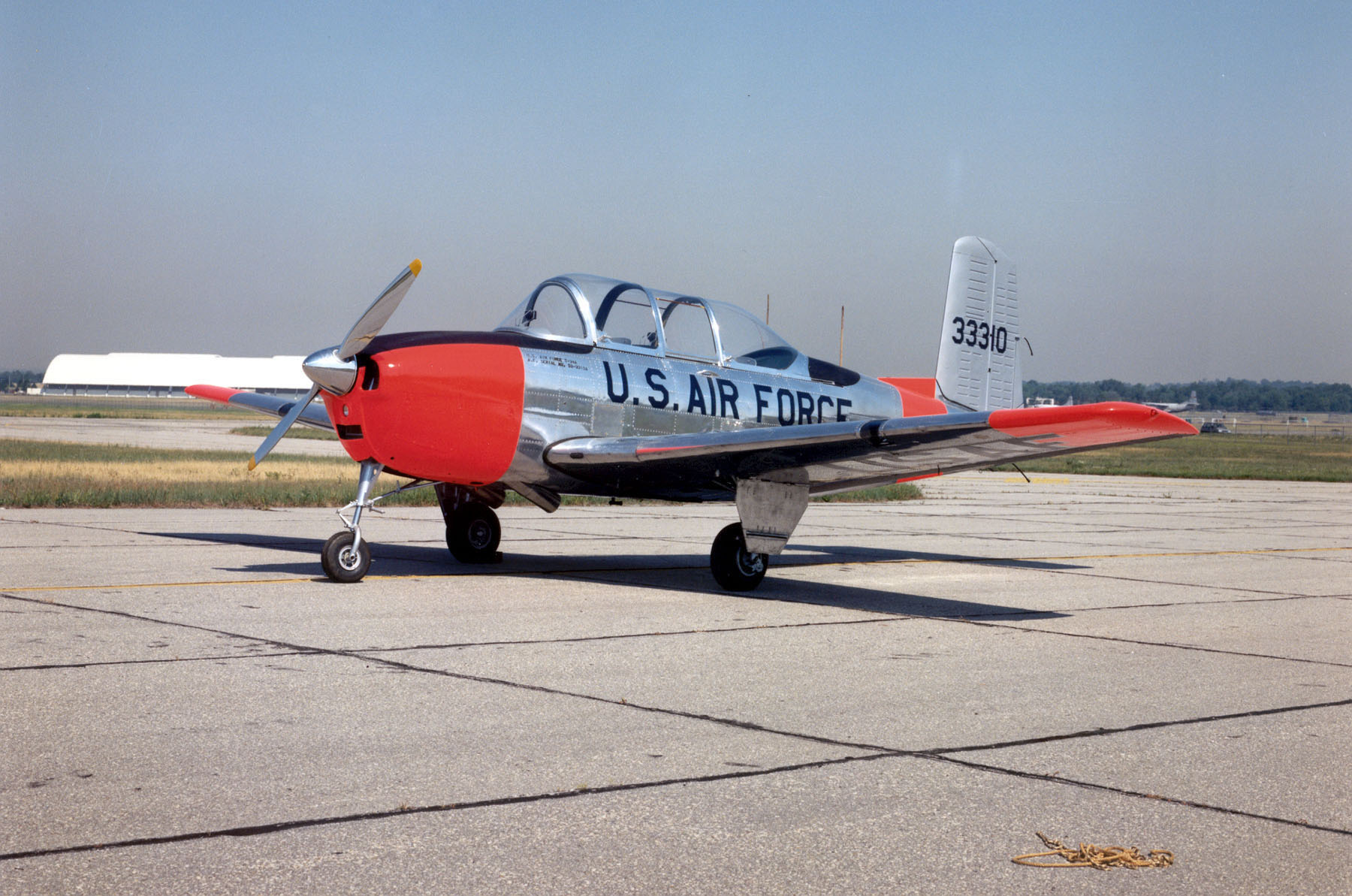



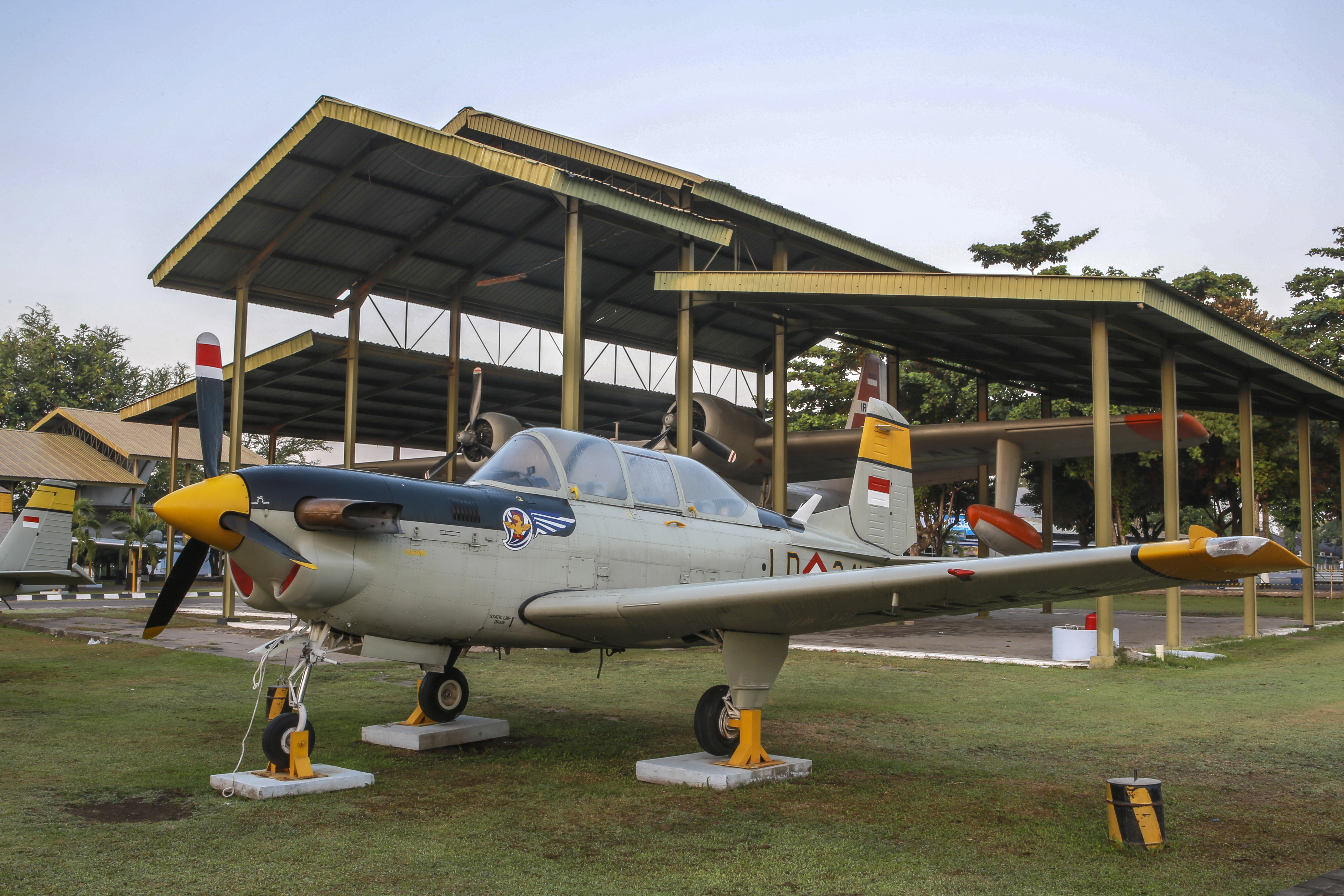
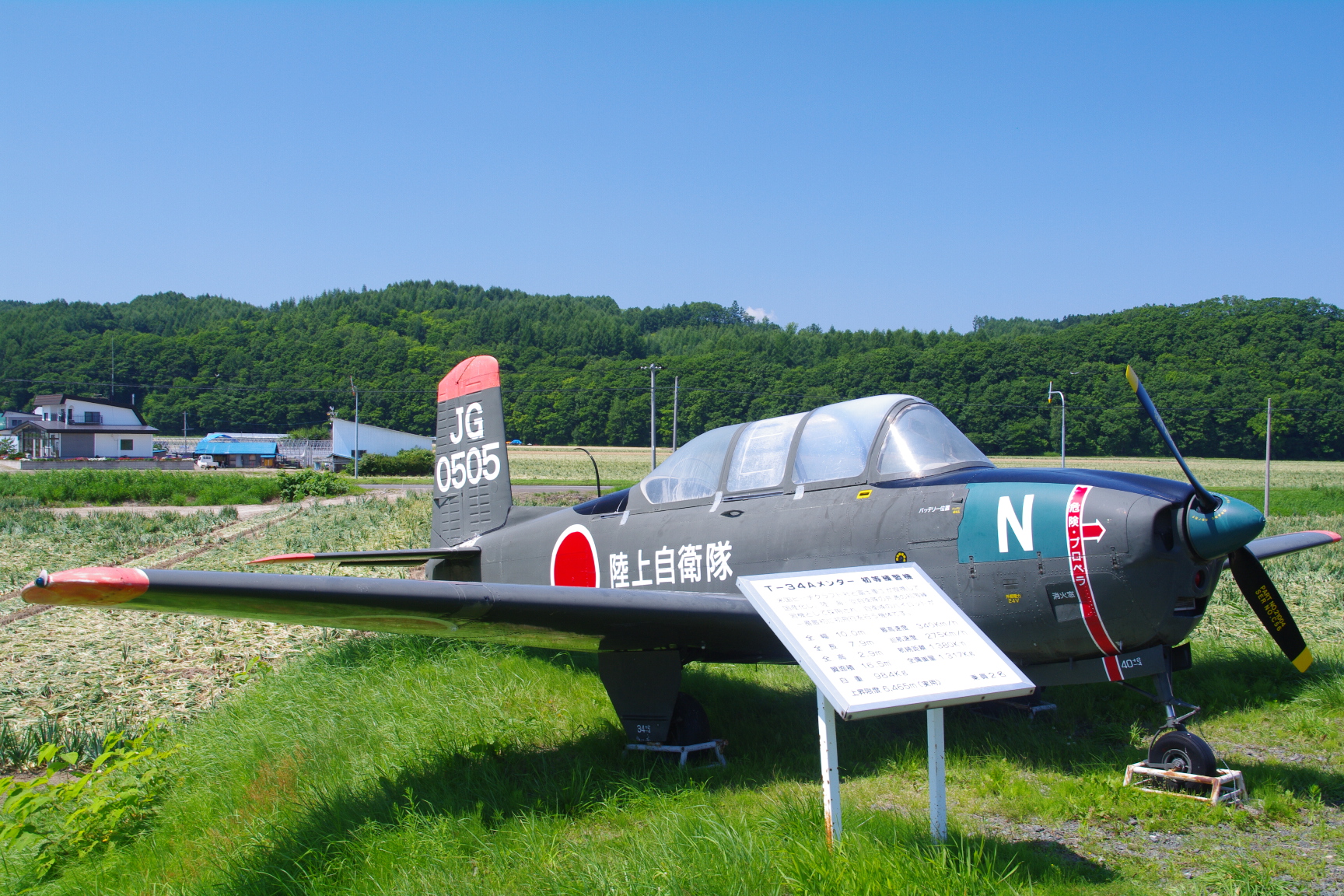
 ;Taylor 1988, p. 329.
;
* Argentine Air Force - Received 15 T-34B from Beechcraft, and 75 built under licence in Argentina by Fabrica Militar de Aviones (FMA).
* Argentine Naval Aviation – 15 T-34C-1 in 1978.
;
* Bolivian Air Force – Received 11 T-34A and Bs from Uruguay in 2000. RCAF Cpurses 5409 and 5411, RCAF Station, Penhold, Alberta
;
* Royal Canadian Air Force - 25 T-34A built in Canada by Canadian Car and Foundry evaluated from 1954 to 1956 with RCAF Courses 5409 and 5411, RCAF Station Penhold, Alberta, until donated to other air forces.
;Taylor 1988, p. 329.
;
* Argentine Air Force - Received 15 T-34B from Beechcraft, and 75 built under licence in Argentina by Fabrica Militar de Aviones (FMA).
* Argentine Naval Aviation – 15 T-34C-1 in 1978.
;
* Bolivian Air Force – Received 11 T-34A and Bs from Uruguay in 2000. RCAF Cpurses 5409 and 5411, RCAF Station, Penhold, Alberta
;
* Royal Canadian Air Force - 25 T-34A built in Canada by Canadian Car and Foundry evaluated from 1954 to 1956 with RCAF Courses 5409 and 5411, RCAF Station Penhold, Alberta, until donated to other air forces. ;
* Chilean Air Force
* Chilean Navy
;
* Colombian Air Force – Purchased 50 T-34s in 1954, with six more acquired in 1970 and 10 in 1977. The final T-34 was retired in December 2013.
;
* Ecuadorian Air Force
*
;
* Chilean Air Force
* Chilean Navy
;
* Colombian Air Force – Purchased 50 T-34s in 1954, with six more acquired in 1970 and 10 in 1977. The final T-34 was retired in December 2013.
;
* Ecuadorian Air Force
*

"World's Air Forces 1980"
'' Flight International'', Vol. 118, No. 3726. 4 October 1980. pp. 1323–1378. .
Hawker Beechcraft T-34 page
US Navy Fact File: T-34C Turbo-Mentor on Navy.mil
T-34 Association
Manual: (1958) T.O. 1T-34A-1 Flight Handbook T-34A USAF Series
T-34 Turkey-T-34's Protect and Preserve the Association -Hur Kus Aviation Club
{{Authority control T-34 1940s United States military trainer aircraft Single-engined tractor aircraft Low-wing aircraft Aircraft first flown in 1948 Single-engined turboprop aircraft
Design and development
The T-34 was the brainchild of Walter Beech, who developed it as the Beechcraft Model 45 private venture at a time when there was no defense budget for a new trainer model. Beech hoped to sell it as an economical alternative to the North American T-6/SNJ Texan, then in use by all services of the U.S. military.
 Three initial design concepts were developed for the Model 45, including one with the Bonanza's signature V-tail, but the final design that emerged in 1948 incorporated conventional tail control surfaces for the benefit of the more conservative military (featuring a relatively large unswept vertical fin that would find its way onto the Travel Air twin-engine civil aircraft almost ten years later). The Bonanza's fuselage with four-passenger cabin was replaced with a narrower fuselage incorporating a two-seater tandem cockpit and bubble canopy, which provided greater visibility for the trainee pilot and flight instructor. Structurally, the Model 45 was much stronger than the Bonanza, being designed for +10 ''g'' and −4.5''g'', while the
Three initial design concepts were developed for the Model 45, including one with the Bonanza's signature V-tail, but the final design that emerged in 1948 incorporated conventional tail control surfaces for the benefit of the more conservative military (featuring a relatively large unswept vertical fin that would find its way onto the Travel Air twin-engine civil aircraft almost ten years later). The Bonanza's fuselage with four-passenger cabin was replaced with a narrower fuselage incorporating a two-seater tandem cockpit and bubble canopy, which provided greater visibility for the trainee pilot and flight instructor. Structurally, the Model 45 was much stronger than the Bonanza, being designed for +10 ''g'' and −4.5''g'', while the Continental E-185
The Continental O-470 engine is a family of carbureted and fuel-injected six-cylinder, horizontally opposed, air-cooled aircraft engines that was developed especially for use in light aircraft by Continental Motors. Engines designated "IO" ...
engine of 185 horsepower (hp) at takeoff (less than a third of the power of the T-6's engine) was the same as that fitted to contemporary Bonanzas.Phillips, Edward H. ''Beechcraft – Pursuit of Perfection, A History of Beechcraft Airplanes''. Eagan, Minnesota: Flying Books, 1992. .
Following the prototype were three Model A45T aircraft, the first two with the same engine as the prototype and the third with a Continental E-225
The Continental O-470 engine is a family of carbureted and fuel-injected six-cylinder, horizontally opposed, air-cooled aircraft engines that was developed especially for use in light aircraft by Continental Motors. Engines designated "IO" ...
, which would prove to be close to the production version. Production did not begin until 1953, when Beechcraft began delivering T-34As to the United States Air Force (USAF) and similar Model B45 aircraft for export. Production of the T-34B for the United States Navy (USN) began in 1955, this version featuring a number of changes reflecting the different requirements of the two services. The T-34B had only differential braking for steering control on the ground instead of nosewheel steering, additional wing dihedral and, to cater for the different heights of pilots, adjustable rudder pedals instead of the moveable seats of the T-34A.Morris, Frank"A Short History of the Beechcraft Mentor."
''philfarq.com''. Retrieved: 13 November 2007. T-34A production was completed in 1956, with T-34Bs being built until October 1957 and licensed B45 versions built in Canada (125 manufactured by Canadian Car and Foundry), Japan (173 built by Fuji Heavy Industries), and Argentina (75 by FMA) until 1958. Beechcraft delivered the last Model B45s in 1959. Total production of the Continental-engined versions in the US and abroad was 1,904 aircraft.
Model 73 Jet Mentor
 In 1955 Beechcraft developed a jet-engined derivative, again as a private venture, and again in the hope of winning a contract from the US military. The Model 73 Jet Mentor shared many components with the piston-engined aircraft; major visual differences were the redesigned cockpit which was relocated further forward in the fuselage and the air intakes for the jet engine in the wing roots, supplying air to a single
In 1955 Beechcraft developed a jet-engined derivative, again as a private venture, and again in the hope of winning a contract from the US military. The Model 73 Jet Mentor shared many components with the piston-engined aircraft; major visual differences were the redesigned cockpit which was relocated further forward in the fuselage and the air intakes for the jet engine in the wing roots, supplying air to a single Continental J69
The Teledyne CAE J69 was a small turbojet engine originally produced by Continental Aviation and Engineering (CAE) under license from Turbomeca. The J69 was a development of the Turbomeca Marboré II. It powered a number of U.S. drones, missil ...
jet engine in the rear fuselage.Bridgman 1956, pp. 230–231. The first flight of the Model 73, registered N134B, was on 18 December 1955. The Model 73 was evaluated by the USAF, which ordered the Cessna T-37, and the USN, which decided upon the Temco TT Pinto. After initial testing at the Naval Air Test Center at NAS Patuxent River, Maryland, the Navy tested the feasibility of using the TT Pinto as a jet-powered trainer for primary flight training in 1959, but discontinued use of the aircraft by December 1960 and discarded all examples, returning to the piston-powered T-34B Mentor and North American T-28 Trojan for its primary flight training requirements. The Beechcraft Model 73 was not put into production and the sole prototype is displayed at the Kansas Aviation Museum
The Kansas Aviation Museum is a museum located in Wichita, Kansas, United States, near 31st South and George Washington Blvd. The building was the former Wichita Municipal Airport terminal from 1935 to 1954.
The Museum features many display a ...
.
T-34C Turbo-Mentor
 After a production hiatus of almost 15 years, the T-34C Turbo-Mentor powered by a
After a production hiatus of almost 15 years, the T-34C Turbo-Mentor powered by a Pratt & Whitney Canada PT6
The Pratt & Whitney Canada PT6 is a turboprop aircraft engine produced by Pratt & Whitney Canada.
Its design was started in 1958, it first ran in February 1960, first flew on 30 May 1961, entered service in 1964 and has been continuously upda ...
A-25 turboprop engine was developed in 1973. Development proceeded at the behest of the USN, which supplied two T-34Bs for conversion. After re-engining with the PT6, the two aircraft were redesignated as YT-34Cs, the first of these flying with turboprop power for the first time on 21 September 1973.Taylor, M. J. H., ed. ''Jane's American Fighting Aircraft of the 20th Century''. Lombard, IL: Mallard Press, 1991. . Mentor production restarted in 1975 for deliveries of T-34Cs to the USN and of the T-34C-1 armed version for export customers in 1977, this version featuring four underwing hardpoint
A hardpoint is an attachment location on a structural frame designed to transfer force and carry an external or internal load. The term is usually used to refer to the mounting points (more formally known as a weapon station or station) on the ...
s. The last Turbo-Mentor rolled off the production line in 1990.
Since the late 1970s, T-34Cs have been used by the Naval Air Training Command to train numerous Naval Aviator
Naval aviation is the application of military air power by navies, whether from warships that embark aircraft, or land bases.
Naval aviation is typically projected to a position nearer the target by way of an aircraft carrier. Carrier-based a ...
s and Naval Flight Officers for the U.S. Navy, U.S. Marine Corps
The United States Marine Corps (USMC), also referred to as the United States Marines, is the maritime land force service branch of the United States Armed Forces responsible for conducting expeditionary and amphibious operations through comb ...
, U.S. Coast Guard, and numerous NATO and Allied nations. With over 35 years of service, the T-34C has been completely replaced by the T-6 Texan II.
Operational history
U.S. Air Force and Civil Air Patrol
The first flight of the Model 45 was on 2 December 1948, by Beechcraft test pilot Vern Carstens. In 1950, the USAF ordered three Model A45T test aircraft, which were given the military designation YT-34. A long competition followed to determine a new trainer, and in 1953 the Air Force put the Model 45 into service as the T-34A Mentor, while the USN followed in May 1955 with the T-34B. After extensive testing, the USAF ordered the Mentor into production as the T-34A in early 1953. The first production T-34A was delivered toEdwards Air Force Base
Edwards Air Force Base (AFB) is a United States Air Force installation in California. Most of the base sits in Kern County, but its eastern end is in San Bernardino County and a southern arm is in Los Angeles County. The hub of the base is E ...
, California, in October 1953 for evaluation, and deliveries to the Air Training Command
Air Training Command (ATC) is a former United States Air Force (USAF) Major Command designation. It was headquartered at Randolph Air Force Base, Texas, but was initially formed at Barksdale Air Force Base, Louisiana. It was re-designated as Ai ...
(ATC) began in 1954. The T-34A commenced service as USAF's initial primary flight trainer at "contract" pilot training air bases across the southern United States, replacing extant North American AT-6 Texan trainers. Following training in the T-34A, USAF pilot trainees would advance to the North American T-28A Trojan
The North American Aviation T-28 Trojan is a radial-engine military trainer aircraft manufactured by North American Aviation and used by the United States Air Force and United States Navy beginning in the 1950s. Besides its use as a trainer, ...
for intermediate training.
The T-34A Mentor remained the standard USAF primary trainer until the introduction of the Cessna T-37 Tweet jet trainer in the late 1950s, replacing both the T-34A and T-28A. This also coincided with ATC's implementation of the Undergraduate Pilot Training (UPT) syllabus at various air force bases in the United States under ATC claimancy and phaseout and closure of the contract pilot training air bases. As they were replaced by T-37s, many T-34As were turned over to USAF aero clubs at air force bases in the United States and USAF air bases overseas. In all, the USAF acquired 450 T-34As.
As the U.S. Air Force replaced the last of their T-34As at the beginning of the 1960s, their role taken over by the propeller-driven T-41 Mescalero and the T-37 Tweet primary jet trainer in UPT, those T-34As not allocated to USAF aero clubs or marked for foreign military sales or transfers were turned over to the USAF Auxiliary, the Civil Air Patrol
Civil Air Patrol (CAP) is a congressionally chartered, federally supported non-profit corporation that serves as the official civilian auxiliary of the United States Air Force (USAF). CAP is a volunteer organization with an aviation-minded mem ...
, for use as search aircraft. However, the T-34A's low wing limited its utility in an aerial search and rescue role, and maintenance issues, particularly expensive wing spar repairs that became apparent in the late 1990s, resulted in the last of the former USAF T-34As being withdrawn from CAP service by 2003.
U.S. Navy and U.S. Marine Corps
The U.S. Navy kept the T-34B operational as a Naval Air Training Command initial primary trainer at the former Naval Air StationSaufley Field
Saufley Field is a military airport and support facility located in unincorporated Escambia County, Florida, United States, five nautical miles (9 km) west of the central business district of Pensacola.
It is an active U.S. Navy facility ...
, Florida until the mid-1970s and as a Navy Recruiting Command
The United States Navy Recruiting Command (NRC or NAVCRUITCOM) is located in Millington, Tennessee. It aims to recruit both enlisted sailors and prospective commissioned officers for the United States Navy. NRC covers the entire United States wit ...
aircraft until the early 1990s when the last examples were retired as an economy move. Others continue to remain under U.S. Navy control as part of flying clubs at naval air stations and marine corps air stations.
Beginning in 1975, the turbine-powered T-34C Turbomentor was introduced as the Navy's new primary flight trainer for Student Naval Aviator
Naval aviation is the application of military air power by navies, whether from warships that embark aircraft, or land bases.
Naval aviation is typically projected to a position nearer the target by way of an aircraft carrier. Carrier-based a ...
s, and began replacing the North American T-28 Trojan with training air wings at NAS Whiting Field, Florida and NAS Corpus Christi, Texas. In the mid-1980s, it also commenced service as a basic trainer for Student Naval Flight Officers at NAS Pensacola, Florida
The T-34C is no longer used as a primary training aircraft for U.S. Navy, U.S. Marine Corps
The United States Marine Corps (USMC), also referred to as the United States Marines, is the maritime land force service branch of the United States Armed Forces responsible for conducting expeditionary and amphibious operations through comb ...
and U.S. Coast Guard Student Naval Aviators and various NATO/Allied/Coalition student pilots training under U.S. Navy auspices. It has been replaced by the T-6 Texan II. Training Squadron TWENTY-EIGHT at NAS Corpus Christi's Training Air Wing FOUR recently retired the T-34C as a Naval Primary Training Aircraft according to Chief of Naval Aviation Training (CNATRA) PAO, joining Training Air Wing SIX at NAS Pensacola, Training Air Wing FIVE at NAS Whiting Field and Training Air Wing FOUR's Training Squadron TWENTY-SEVEN at NAS Corpus Christi had already transitioned to the T-6A and T-6B models.
Several other T-34Cs also remain in service with the Naval Air Test Center at NAS Patuxent River, Maryland and as aerial spotter aircraft with F/A-18 Fleet Replacement Squadrons (FRS) and Strike Fighter Weapons and Tactics Schools at NAS Oceana, Virginia; NAS Lemoore, California; and MCAS Miramar, California; and the Naval Strike and Air Warfare Center (NSAWC) at NAS Fallon, Nevada.
U.S. Army
The United States Army received six ex-U.S. Navy T-34C, used as test platforms and chase planes atEdwards Air Force Base
Edwards Air Force Base (AFB) is a United States Air Force installation in California. Most of the base sits in Kern County, but its eastern end is in San Bernardino County and a southern arm is in Los Angeles County. The hub of the base is E ...
, California and Fort Bragg
Fort Bragg is a military installation of the United States Army in North Carolina, and is one of the largest military installations in the world by population, with around 54,000 military personnel. The military reservation is located within Cum ...
, North Carolina.Harding 1990, pp. 27–28.
NASA
NASAArmstrong Flight Research Center
The NASA Neil A. Armstrong Flight Research Center (AFRC) is an aeronautical research center operated by NASA. Its primary campus is located inside Edwards Air Force Base in California and is considered NASA's premier site for aeronautical res ...
(formerly the Dryden Flight Research Center) at Edwards, California has operated two T-34C aircraft. The first aircraft was previously flown at the Glenn Research Center in Cleveland, Ohio
Cleveland ( ), officially the City of Cleveland, is a city in the U.S. state of Ohio and the county seat of Cuyahoga County. Located in the northeastern part of the state, it is situated along the southern shore of Lake Erie, across the U.S. ...
, where it was used for propulsion experiments involving turboprop engines. In 1996 this aircraft was moved Dryden as a chase aircraft. That aircraft was returned to the U.S. Navy in 2002. The second T-34C was obtained in early 2005 from the Naval Air Warfare Center Aircraft Division (NAWCAD) at NAS Patuxent River, where it was due to be retired. At Armstrong, the T-34C is primarily used for chasing remotely piloted unmanned air vehicles which fly slower than NASA's F/A-18 mission support aircraft can fly. As a NASA mission support chase plane, the back seat would be occupied by a photographer or flight test engineer during research missions. It is also used for required pilot proficiency flying.
Non-U.S. military service
As of 2007, Mentors are still used by several air forces and navies. From 1978, the T-34C Turbo-Mentor was the Argentine Naval Aviation basic trainer used by the 1st Naval Aviation Force (Training), alongside 15 T-34C-1 light attack aircraft forming the Fourth Naval Air Attack Squadron. During the 1982Falklands War
The Falklands War ( es, link=no, Guerra de las Malvinas) was a ten-week undeclared war between Argentina and the United Kingdom in 1982 over two British dependent territories in the South Atlantic: the Falkland Islands and its territorial de ...
, four T-34C-1s were deployed to Port Stanley on 25 April 1982, primarily to be employed in a reconnaissance role. The main encounter with British forces occurred on 1 May 1982 when three Turbo-Mentors attacked a Royal Navy Westland Sea King helicopter in the area of Berkeley Sound but were intercepted by Royal Navy Sea Harriers flown by Lt 'Soapy' Watson and Lt Cdr 'Sharky' Ward of 801 Naval Air Squadron flying from HMS Invincible
Seven ships of the Royal Navy have been named HMS ''Invincible''.
* was originally the French 74-gun ship of the line ''L'Invincible'', captured off Cape Finisterre in 1747. She was the first purpose-built 74-gun ship of the line to serve in th ...
, with one of the T-34Cs being damaged by cannon fire from Ward's aircraft. The four T-34C-1 Turbo-Mentors continued to operate, flying a few reconnaissance missions, but were redeployed to Borbon Station where they were ultimately destroyed by the SAS Raid on Pebble Island
The Raid on Pebble Island was a raid by British Special Forces on Pebble Island's airfield during the Falklands War, and took place on the night of 14–15 May 1982. Pebble Island is one of the smaller Falkland Islands, lying north of West Fal ...
on 15 May 1982. Although all four hulks remained on the island for a considerable length of time, eventually, 0729/(1-A)411 was recovered on 10 June 1983 and stored for future display at the Fleet Air Arm Museum.
Civilian use
 In 2004, due to a series of crashes involving in-flight structural failure during simulated combat flights, the entire US civilian fleet of T-34A/Bs was grounded by the Federal Aviation Administration. The grounding has since been eased to a slate of restrictions on the permitted flight envelope. Via a series of Airworthiness Directives (ADs) established by or Alternate Methods of Compliance (AMOCs) negotiated with the FAA, including installation of certain, approved structural modifications to the wing spar and other repairs, the T-34A and T-34B fleet in 2011 has been restored to full flight status by FAA at the Mentor's originally designed limitations, provided each individual example is compliant with those ADs and AMOCs.
The Mentor is the aircraft used by the
In 2004, due to a series of crashes involving in-flight structural failure during simulated combat flights, the entire US civilian fleet of T-34A/Bs was grounded by the Federal Aviation Administration. The grounding has since been eased to a slate of restrictions on the permitted flight envelope. Via a series of Airworthiness Directives (ADs) established by or Alternate Methods of Compliance (AMOCs) negotiated with the FAA, including installation of certain, approved structural modifications to the wing spar and other repairs, the T-34A and T-34B fleet in 2011 has been restored to full flight status by FAA at the Mentor's originally designed limitations, provided each individual example is compliant with those ADs and AMOCs.
The Mentor is the aircraft used by the Lima Lima Flight Team
The Lima Lima Flight Team is a precision formation flying demonstration team based in Naperville, Illinois.
The name derives from the FAA identifier of the field where the team originated. Naper Aero Club (LL-10) is located in the western suburbs ...
and Dragon Flight, both civilian demonstration teams. It was also used by aerobatic pilot Julie Clark
Julie E. Clark (born June 27, 1948) is a retired American aerobatic air show aviator and commercial airline pilot. She started her commercial flying career with Golden West Airlines as a first officer and ended it in 2003 as a Northwest Airl ...
, who flew her T-34 "Free Spirit" (registration N134JC) at air shows.
Variants
 ;YT-34
:Prototype, three built.
;T-34A
:US Air Force trainer. Replaced by the Cessna T-37 around 1960 (450 built).
;T-34B
:US Navy trainer. Used as a trainer until 1976, when VT-1 and VT-5 were decommissioned. It was replaced by the T-34C (423 built by Beechcraft). T-34Bs were flown by pilots assigned to the
;YT-34
:Prototype, three built.
;T-34A
:US Air Force trainer. Replaced by the Cessna T-37 around 1960 (450 built).
;T-34B
:US Navy trainer. Used as a trainer until 1976, when VT-1 and VT-5 were decommissioned. It was replaced by the T-34C (423 built by Beechcraft). T-34Bs were flown by pilots assigned to the Navy Recruiting Command
The United States Navy Recruiting Command (NRC or NAVCRUITCOM) is located in Millington, Tennessee. It aims to recruit both enlisted sailors and prospective commissioned officers for the United States Navy. NRC covers the entire United States wit ...
until the mid-1990s.
;YT-34C
:Two T-34Bs were fitted with turboprop engines, and were used as T-34C prototypes.
;T-34C Turbo-Mentor
:Two-seat primary trainer, fitted with a turboprop engine.
;T-34C-1
:Equipped with hardpoints for training or light attack, able to carry of weapons on four underwing pylons. The armament could include flares, incendiary bombs, rocket or gun pods and antitank missiles. Widely exported.
;Turbo-Mentor 34C
:Civilian version
;Allison Turbine Mentor
:Conversion of surplus T-34 Mentors to be powered by Allison Model 250
The Allison Model 250, now known as the Rolls-Royce M250, (US military designations T63 and T703) is a highly successful turboshaft engine family, originally developed by the Allison Engine Company in the early 1960s. The Model 250 has been pro ...
turboprop engines.Taylor 1988, p. 325.
;Model 73 Jet Mentor:Powered by a Continental J69-T-9
The Teledyne CAE J69 was a small turbojet engine originally produced by Teledyne Turbine Engines, Continental Aviation and Engineering (CAE) under license from Safran Helicopter Engines, Turbomeca. The J69 was a development of the Turbomeca Marbo ...
turbojet engine. The sole aircraft first flew on 18 December 1955.
Operators
Military operators




 ;
* Chilean Air Force
* Chilean Navy
;
* Colombian Air Force – Purchased 50 T-34s in 1954, with six more acquired in 1970 and 10 in 1977. The final T-34 was retired in December 2013.
;
* Ecuadorian Air Force
*
;
* Chilean Air Force
* Chilean Navy
;
* Colombian Air Force – Purchased 50 T-34s in 1954, with six more acquired in 1970 and 10 in 1977. The final T-34 was retired in December 2013.
;
* Ecuadorian Air Force
* Ecuadorian Navy
The Ecuadorian Navy ( es, Armada del Ecuador) is an Ecuadorian entity responsible for the surveillance and protection of national maritime territory and has a personnel of 9,127 men to protect a coastline of 2,237 km which reaches far into t ...
;
;
;
;
* Indonesian Air Force
;
* Japan Air Self-Defense Force
* Japan Ground Self-Defense Force
;
;
* Royal Moroccan Air Force
;
* Peruvian Naval Aviation
The Peruvian Naval Aviation ( es, Fuerza de Aviación Naval) is the air branch of the Peruvian Navy. It was originally formed in 1919 as the Naval Aviators Corps (''Cuerpo de Aviadores Navales'') but was merged in 1932 with the Peruvian Army Aviat ...
;
* Philippine Air Force
The Philippine Air Force (PAF) ( tgl, Hukbong Himpapawid ng Pilipinas, , Army of the Air of the Philippines) ( es, Ejército Aérea del Filipinas, , Ejército de la Aérea de la Filipinas) is the aerial warfare service branch of the Armed Forc ...
;
* Royal Saudi Air Force''Air International'' June 1972, p. 302.
;
;
* Republic of China Air Force - Purchased 49 T-34Cs in 1985, 40 of them are still in service.
;
* Turkish Air Force
;
* United States Air Force
* United States Army
* United States Navy
* United States Marine Corps
* United States Coast Guard
* Civil Air Patrol
Civil Air Patrol (CAP) is a congressionally chartered, federally supported non-profit corporation that serves as the official civilian auxiliary of the United States Air Force (USAF). CAP is a volunteer organization with an aviation-minded mem ...
;
* Uruguayan Air Force
* Uruguayan Navy
;
Civil operators
; * Turkish Aeronautical Association ;: * Dragon Flight *Lima Lima Flight Team
The Lima Lima Flight Team is a precision formation flying demonstration team based in Naperville, Illinois.
The name derives from the FAA identifier of the field where the team originated. Naper Aero Club (LL-10) is located in the western suburbs ...
* NASA
* North Carolina Forest Service
Specifications (T-34C)

See also
References
Citations
Bibliography
* "Arabian Fledgling...the Royal Saudi Air Force". '' Air Enthusiast'', June 1972, Vol. 2, No. 6. pp. 300–308. * Bridgman, Leonard. ''Jane's All The World's Aircraft 1956–57''. New York: The McGraw-Hill Book Company, Inc., 1956. * Drendel Lou. ''T-34 Mentor in Action''. Carrollton, Texas: Squadron/Signal Publications, 1990. . * "Fuerza Aérea Boliviana". ''International Air Power Review''. Volume 1, Summer 2001. pp. 28–31. . * Harding, Stephen. ''U.S. Army Aircraft Since 1947''. Shrewsbury, UK: Airlife Publishing, 1990. . * Morgan, David. ''Hostile Skies: My Falklands Air War''. London: Phoenix Publishing, 2006. . * * Taylor, John W.R. ''Jane's All The World's Aircraft 1988–89''. Coulsdon, UK: Jane's Defence Data, 1988. . * Wheeler, Barry C"World's Air Forces 1980"
'' Flight International'', Vol. 118, No. 3726. 4 October 1980. pp. 1323–1378. .
External links
Hawker Beechcraft T-34 page
US Navy Fact File: T-34C Turbo-Mentor on Navy.mil
T-34 Association
Manual: (1958) T.O. 1T-34A-1 Flight Handbook T-34A USAF Series
T-34 Turkey-T-34's Protect and Preserve the Association -Hur Kus Aviation Club
{{Authority control T-34 1940s United States military trainer aircraft Single-engined tractor aircraft Low-wing aircraft Aircraft first flown in 1948 Single-engined turboprop aircraft